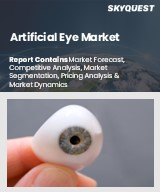
|
시장보고서
상품코드
1677132
세계의 스마트 의지 시장(2025-2030년) : 제품, 재료, 최종 사용자, 유통 채널별 예측Smart Prosthetics Market by Product, Material, End User, Distribution Channel - Global Forecast 2025-2030 |
||||||
스마트 의지 시장은 2024년에는 8억 4,011만 달러를 달성하였고 CAGR 8.21%로 성장하여 2025년에는 9억 639만 달러, 2030년에는 13억 4,926만 달러에 이를 것으로 예측되고 있습니다.
| 주요 시장 통계 | |
|---|---|
| 기준연도(2024) | 8억 4,011만 달러 |
| 추정연도(2025) | 9억 639만 달러 |
| 예측연도(2030) | 13억 4,926만 달러 |
| CAGR(%) | 8.21% |
스마트 의지 시장은 놀라운 진화를 이루고 있으며, 기술적 진보와 생물의학적 혁신이 융합하여 이동성을 재정의하고 삶의 질을 향상시키고 있습니다. 최근 센서 통합과 로봇 공학의 비약적 진보는 보다 기능적일 뿐만 아니라 사용자의 역동적인 요구에 직관적으로 적응하는 의지기구 솔루션에 대한 길을 열었습니다. 이러한 혁명적인 시대는 내구성과 성능을 향상시키는 정밀 엔지니어링 노력을 특징으로 하여 환자와 의료 제공업체 모두에게 새로운 신뢰를 제공합니다. 업계가 학제 간 연구와 다른 업종 간의 협력으로 탄생할 수 있는 기회를 활용함에 따라 이해관계자들은 제품 혁신과 탁월한 임상 능력 모두를 추진하는 전략을 점차적으로 도입하고 있습니다.
스마트 의지기기의 혁신은 기존 틀을 넘어 인공지능과 머신러닝을 역동적으로 통합하고 맞춤형 사용자 경험을 제공합니다. 이 통합은 인간의 자연스러운 움직임을 모방하는 실시간 적응 반응을 촉진하고, 기술적 가능성과 일상적인 응용 간의 격차를 채웁니다. 지속 가능성과 비용효과에 중점을 둔 이 시장은 종합적인 연구와 임상의, 연구자, 엔지니어의 협업을 중시하는 생태계에 힘입어 강력한 성장을 이루고 있습니다.
스마트 의지 시장의 변화
스마트 의지 시장은 혁신적인 혁신, 규제 당국의 지원, 진화하는 건강관리 요구에 따라 패러다임 변화를 경험하고 있습니다. 시장의 기업은 임베디드 센서, 실시간 데이터 분석, 바이오 피드백 메커니즘 등의 최첨단 기술을 도입하고 있으며, 이러한 기술이 종합적으로 인간의 바이오메카닉스를 충실히 재현할 수 있는 기기에 공헌하고 있습니다. 이러한 혁신적인 변화는 사용자의 예후를 개선할 뿐만 아니라 맞춤형 재활 치료와 환자 중심 설계라는 새로운 시대의 도래를 알려줍니다. 디지털 기술과 기존 의지기구 제조의 통합은 시장 기준을 재정의하고 재활이 적응이 아니라 강화를 중시하도록 보장합니다.
중요한 동향 중 하나는 모듈식 의지기기의 출현입니다. 이 의지기기를 사용하면 각 개인은 특정 요구 사항에 따라 기기를 맞춤화할 수 있으므로 사용자의 편안함과 실용성이 향상됩니다. 또한 디지털 연결과 원격 의료의 급속한 보급은 원격 모니터링 능력을 가속화하고 대면 진단의 필요성을 줄이는 동시에 지속적인 기기 최적화를 보장합니다. 공동연구의 노력과 여러 분야에 걸친 전문지식이 이러한 개발에 박차를 가해 스마트 의지를 현대 헬스케어 솔루션의 초석으로 자리매김하고 있습니다.
스마트 의지기기 성장을 위한 주요 부문 분석
스마트 의지 시장을 상세하게 분석하면 성장과 혁신을 촉진하는 복잡한 역학을 밝히는 다면적인 세분화 구조를 이해할 수 있습니다. 제품 기반 세분화에서는 하반신 의지에 초점을 맞춘 인공 발목과 인공 무릎 솔루션 검토와 상반신 의지를 포함하여 인공 팔과 인공 손 기술을 통해 분석하는 두 가지 구분으로 나뉘어져 있습니다. 이 분류는 사용자의 요구에 대한 상세한 이해를 가능하게 하고, 각 제품 하위 부문이 직면하는 명확한 기술적 과제를 보여줍니다.
시장 세분화는 알루미늄, 탄소섬유, 세라믹, 폴리프로필렌, 폴리우레탄, 실리콘, 스테인레스 스틸, 열가소성 엘라스토머 및 티타늄을 포함한 다양한 물질에 대해 상세히 조사했습니다. 이 다양한 재료 팔레트는 경량 내구성에서 일상적인 마모 및 충격 조건 하에서의 견고성에 이르기까지 다양한 성능 특성을 지원합니다. 또한 최종 사용자 세분화는 병원, 의지 클리닉 및 재활센터를 구분하여 운영 프로토콜 및 환자 관리 환경이 제품 채택 및 맞춤화에 어떻게 영향을 미치는지 강조합니다. 마지막으로 오프라인과 온라인 경로로 나뉘어진 유통 채널 분석은 의지기기 판매 및 서비스에서 소비자 행동의 진화와 디지털 플랫폼의 확산 증가를 강조합니다.
목차
제1장 서문
제2장 조사 방법
제3장 주요 요약
제4장 시장 개요
제5장 시장 인사이트
- 시장 역학
- 성장 촉진요인
- 첨단 의지를 필요로 하는 정형외과 질환이나 외상 증가
- 의지기기에 대한 정부의 자금 원조와 지원적인 규제 프레임워크
- 억제요인
- 스마트 의지와 관련된 첨단 기술과 제품 개발의 높은 비용
- 기회
- 맞춤형 건강관리 수요 증가에 부응하는 맞춤형 의지 솔루션의 출현
- 경량으로 인체공학에 근거해 설계된 스마트 의지의 혁신
- 과제
- 상호 운용성의 부족과 그에 따른 복잡한 규제 승인
- 성장 촉진요인
- 시장 세분화 분석
- 제품 : 다리 절단 환자의 운동 기능을 회복하기 위한 하반신 의지의 의미
- 최종 사용자 : 사용자의 편안함과 장기적인 인체공학적 통합으로 인해 증가하는 스마트 의지 채택률
- Porter's Five Forces 분석
- PESTEL 분석
- 정치적
- 경제
- 사회
- 기술
- 법률
- 환경
제6장 스마트 의지 시장 : 제품별
- 하반신 의지
- 인공 발목
- 인공 무릎
- 상반신 의지
- 인공 팔
- 인공 손
제7장 스마트 의지 시장 : 재료별
- 알루미늄
- 탄소섬유
- 세라믹
- 폴리프로필렌
- 폴리우레탄
- 실리콘
- 스테인레스 스틸
- 열가소성 엘라스토머(TPE)
- 티타늄
제8장 스마트 의지 시장 : 최종 사용자별
- 병원
- 의지 클리닉
- 재활센터
제9장 스마트 의지 시장 : 유통 채널별
- 오프라인
- 온라인
제10장 아메리카의 스마트 의지 시장
- 아르헨티나
- 브라질
- 캐나다
- 멕시코
- 미국
제11장 아시아태평양의 스마트 의지 시장
- 호주
- 중국
- 인도
- 인도네시아
- 일본
- 말레이시아
- 필리핀
- 싱가포르
- 한국
- 대만
- 태국
- 베트남
제12장 유럽, 중동 및 아프리카의 스마트 의지 시장
- 덴마크
- 이집트
- 핀란드
- 프랑스
- 독일
- 이스라엘
- 이탈리아
- 네덜란드
- 나이지리아
- 노르웨이
- 폴란드
- 카타르
- 러시아
- 사우디아라비아
- 남아프리카
- 스페인
- 스웨덴
- 스위스
- 터키
- 아랍에미리트(UAE)
- 영국
제13장 경쟁 구도
- 시장 점유율 분석(2024)
- FPNV 포지셔닝 매트릭스(2024)
- 경쟁 시나리오 분석
- 전략 분석과 제안
기업 목록
- Advanced Arm Dynamics, Inc.
- Bionic Hope Private Limited
- Bionic Prosthetics & Orthotics Group LLC
- Blatchford Limited
- BrainGate
- BrainRobotics
- College Park Industries
- COVVI
- DEKA Research & Development Corp.
- Endolite
- Fillauer LLC
- Gilde Healthcare Partners BV
- Hanger Clinic
- HDT Global
- Medical Center Orthotics & Prosthetics
- Mobius Bionics LLC
- Open Bionics Ltd
- Otto Bock HealthCare Andina Ltda
- Proactive Technical Orthopaedics Pvt Ltd.
- PROTEOR
- Shijiazhuang Perfect Prosthetic
- Steeper Group
- TASKA Prosthetics Limited
- WillowWood Global LLC.
- Ossur hf
The Smart Prosthetics Market was valued at USD 840.11 million in 2024 and is projected to grow to USD 906.39 million in 2025, with a CAGR of 8.21%, reaching USD 1,349.26 million by 2030.
| KEY MARKET STATISTICS | |
|---|---|
| Base Year [2024] | USD 840.11 million |
| Estimated Year [2025] | USD 906.39 million |
| Forecast Year [2030] | USD 1,349.26 million |
| CAGR (%) | 8.21% |
The smart prosthetics market is undergoing a remarkable evolution, where technological advancements and biomedical innovation converge to redefine mobility and improve quality of life. Recent breakthroughs in sensor integration and robotics have paved the way for prosthetic solutions that are not only more functional but also intuitively adaptive to the dynamic needs of users. This revolutionary era is characterized by a commitment to precision engineering, which offers enhanced durability and performance, thereby instilling renewed confidence in both patients and healthcare providers. As the industry harnesses opportunities stemming from interdisciplinary research and cross-industry collaborations, stakeholders are progressively embracing strategies that drive both product innovation and clinical excellence.
Innovations in smart prosthetics are extending beyond traditional boundaries, offering dynamic integration of artificial intelligence and machine learning to customize user experiences. This integration is facilitating real-time adaptive responses that mimic natural human movement, thus bridging the gap between technological potential and everyday application. With a focus on sustainability and cost-effectiveness, the market has witnessed robust growth, backed by comprehensive studies and an ecosystem that values collaboration between clinicians, researchers, and engineers.
Transformative Shifts in the Smart Prosthetics Market Landscape
The smart prosthetics market is experiencing a paradigm shift driven by transformative innovations, regulatory support, and evolving healthcare needs. Market players are embracing cutting-edge technologies such as embedded sensors, real-time data analytics, and biofeedback mechanisms that collectively contribute to devices capable of closely replicating human biomechanics. These transformative shifts are not only driving improved user outcomes but are also ushering in a new era of personalized rehabilitation procedures and patient-centric design. The integration of digital technologies with traditional prosthetic manufacturing is redefining market standards, ensuring that rehabilitation becomes less about adaptation and more about empowerment.
One significant trend is the emergence of modular prosthetic solutions that enable individuals to customize fittings according to their specific requirements, thereby enhancing user comfort and utility. Moreover, the rapid proliferation of digital connectivity and telemedicine has accelerated remote monitoring capabilities, reducing the need for in-person consultations while ensuring sustained device optimization. Collaborative research initiatives and cross-disciplinary expertise are fueling these developments, cementing the role of smart prosthetics as a cornerstone of modern healthcare solutions.
Key Segmentation Insights for Smart Prosthetic Growth
A detailed analysis of the smart prosthetics market reveals a multifaceted segmentation structure that illuminates the intricate dynamics driving growth and innovation. The product-based segmentation encapsulates a dual division: one focused on lower body prosthetics, which is further examined through the lens of prosthetic ankle and prosthetic knee solutions, and another that encompasses upper body prosthetics, analyzed through prosthetic arm and prosthetic hand technologies. This categorization allows for a nuanced understanding of user requirements and underlines the distinct technical challenges that each product sub-segment faces.
In terms of material segmentation, the market is rigorously studied across various substances including aluminum, carbon fiber, ceramics, polypropylene, polyurethane, silicone, stainless steel, thermoplastic elastomers, and titanium. This diverse material palette caters to a range of performance characteristics from lightweight durability to robustness under daily wear and impact conditions. Furthermore, the end user segmentation distinguishes between hospitals, prosthetic clinics, and rehabilitation centers, highlighting how operational protocols and patient care environments influence product adoption and customization. Finally, distribution channel analysis, divided into offline and online pathways, underscores the evolving consumer behaviors and the increasing penetration of digital platforms in the sales and service of prosthetic devices.
Based on Product, market is studied across Lower Body Prosthetics and Upper Body Prosthetics. The Lower Body Prosthetics is further studied across Prosthetic Ankle and Prosthetic Knee. The Upper Body Prosthetics is further studied across Prosthetic Arm and Prosthetic Hand.
Based on Material, market is studied across Aluminum, Carbon Fiber, Ceramics, Polypropylene, Polyurethane, Silicone, Stainless Steel, Thermoplastic Elastomers (TPE), and Titanium.
Based on End User, market is studied across Hospitals, Prosthetic Clinics, and Rehabilitation Centers.
Based on Distribution Channel, market is studied across Offline and Online.
Key Regional Insights Shaping Market Opportunities
The spatial analysis of the smart prosthetics market elucidates several regional trends that not only mirror local healthcare infrastructure but also reflect economic and regulatory factors governing market dynamics. In the Americas, a combination of advanced medical support systems and a high adoption rate of innovative prosthetic devices is creating a robust market environment. Meanwhile, the region encompassing Europe, the Middle East, and Africa is witnessing a progressive shift through increased investment in medical research and access to cutting-edge technology, even as varying regulatory landscapes present a mix of challenges and opportunities. The Asia-Pacific region, with its rapidly expanding healthcare infrastructure and significant technological investments, continues to emerge as a critical hub for market expansion.
Regional differentiation plays a vital role in defining market entry strategies, as localized preferences and operational nuances drive the adoption rate and customization practices of prosthetic devices. Conversant with these regional insights, stakeholders are well-positioned to tailor solutions that meet localized demands, whether it involves regulatory compliances, cultural adaptability, or market readiness for digital health innovations.
Based on Region, market is studied across Americas, Asia-Pacific, and Europe, Middle East & Africa. The Americas is further studied across Argentina, Brazil, Canada, Mexico, and United States. The United States is further studied across California, Florida, Illinois, New York, Ohio, Pennsylvania, and Texas. The Asia-Pacific is further studied across Australia, China, India, Indonesia, Japan, Malaysia, Philippines, Singapore, South Korea, Taiwan, Thailand, and Vietnam. The Europe, Middle East & Africa is further studied across Denmark, Egypt, Finland, France, Germany, Israel, Italy, Netherlands, Nigeria, Norway, Poland, Qatar, Russia, Saudi Arabia, South Africa, Spain, Sweden, Switzerland, Turkey, United Arab Emirates, and United Kingdom.
Profiled Innovations and Market Leaders in Prosthetics
Market leadership in the smart prosthetics arena is characterized by a plethora of innovative companies that are setting benchmarks in technological integration and user-centric design. Leaders such as Advanced Arm Dynamics, Inc. and Bionic Hope Private Limited have distinguished themselves through inventive approaches that seamlessly merge clinical insights with advanced robotics, ensuring that prosthetic devices are not just tools but vital components in everyday life. Organizations including Bionic Prosthetics & Orthotics Group LLC, Blatchford Limited, and BrainGate continue to invest in next-generation technologies to craft enhanced prosthetic solutions.
Key innovators like BrainRobotics, College Park Industries, COVVI, and DEKA Research & Development Corp. leverage extensive research and developmental expertise to push the boundaries of functional mobility. Companies such as Endolite, Fillauer LLC, and Gilde Healthcare Partners BV are instrumental in redefining clinical pathways by integrating data-driven insights and customization. Moreover, Hanger Clinic and HDT Global, alongside other notable players such as Medical Center Orthotics & Prosthetics, Mobius Bionics LLC, Open Bionics Ltd, Otto Bock HealthCare Andina Ltda, Proactive Technical Orthopaedics Pvt Ltd., PROTEOR, Shijiazhuang Perfect Prosthetic, Steeper Group, TASKA Prosthetics Limited, WillowWood Global LLC., and Ossur hf, are collaboratively setting a high standard in the market, reflecting a commitment to both clinical excellence and innovative design.
The report delves into recent significant developments in the Smart Prosthetics Market, highlighting leading vendors and their innovative profiles. These include Advanced Arm Dynamics, Inc., Bionic Hope Private Limited, Bionic Prosthetics & Orthotics Group LLC, Blatchford Limited, BrainGate, BrainRobotics, College Park Industries, COVVI, DEKA Research & Development Corp., Endolite, Fillauer LLC, Gilde Healthcare Partners BV, Hanger Clinic, HDT Global, Medical Center Orthotics & Prosthetics, Mobius Bionics LLC, Open Bionics Ltd, Otto Bock HealthCare Andina Ltda, Proactive Technical Orthopaedics Pvt Ltd., PROTEOR, Shijiazhuang Perfect Prosthetic, Steeper Group, TASKA Prosthetics Limited, WillowWood Global LLC., and Ossur hf. Actionable Recommendations for Forward-Thinking Industry Leaders
Industry leaders are encouraged to adopt a multi-layered strategic approach that emphasizes continuous innovation and market responsiveness. First, invest in R&D initiatives that incorporate advanced sensor technology and machine learning algorithms, as this will drive the development of more intuitive and adaptive prosthetic solutions. It is imperative to establish collaborative networks involving academic institutions, clinical partners, and technology innovators to foster comprehensive research that can translate breakthroughs into competitive advantages.
Leaders should also consider diversifying their material use strategies to harness the benefits of lightweight yet durable materials such as carbon fiber and titanium, while simultaneously assessing cost efficiencies and sustainability. Tapping into regional insights and understanding the distinct demands of hospital environments, prosthetic clinics, and rehabilitation centers can further tailor product offerings. Additionally, optimizing distribution channels by integrating digital platforms with traditional offline methods can broaden market access. Regularly updating post-market surveillance systems will ensure alignment with regulatory standards and facilitate early identification of emerging trends, thereby maintaining a sustained growth trajectory.
Finally, investing in consumer education programs and support networks will amplify user confidence and accelerate adoption rates, ensuring that product innovation is matched by unprecedented user satisfaction and long-term industry growth.
Conclusion and Future Prospects
In conclusion, the smart prosthetics market represents a transformative shift in healthcare technology, where relentless innovation meets consumer-centric design. Driven by advancements in sensor integration, robotics, and artificial intelligence, the market is poised for exponential growth. The segmentation analysis reveals not only a diverse technological landscape that spans both lower and upper body prosthetics but also a dynamic interplay between material innovations and varied end-user requirements. Regional insights further underscore that the robustness of health infrastructures in the Americas, the unique challenges and opportunities within Europe, the Middle East, and Africa, and the rapid advancements in Asia-Pacific collectively dictate global market trends.
The success of smart prosthetics hinges upon the ability of industry players to adapt quickly to evolving technological demands, invest in robust research initiatives, and tailor products to regional specifics. As stakeholders work collaboratively to overcome existing hurdles, the future promises a new era of custom-fit prosthetic solutions that can significantly improve user autonomy and overall quality of life. This dynamic market environment is not merely about technological leaps but also about building resilient ecosystems that prioritize patient outcomes and sustainable innovation.
Table of Contents
1. Preface
- 1.1. Objectives of the Study
- 1.2. Market Segmentation & Coverage
- 1.3. Years Considered for the Study
- 1.4. Currency & Pricing
- 1.5. Language
- 1.6. Stakeholders
2. Research Methodology
- 2.1. Define: Research Objective
- 2.2. Determine: Research Design
- 2.3. Prepare: Research Instrument
- 2.4. Collect: Data Source
- 2.5. Analyze: Data Interpretation
- 2.6. Formulate: Data Verification
- 2.7. Publish: Research Report
- 2.8. Repeat: Report Update
3. Executive Summary
4. Market Overview
5. Market Insights
- 5.1. Market Dynamics
- 5.1.1. Drivers
- 5.1.1.1. Rising prevalence of orthopedic disorders and injuries necessitating advanced prosthetic devices
- 5.1.1.2. Government funding and supportive regulatory frameworks for prosthetics
- 5.1.2. Restraints
- 5.1.2.1. High cost of advanced technology and product development associated with smart prosthetics
- 5.1.3. Opportunities
- 5.1.3.1. Emergence of customizable prosthetic solutions catering to the growing demand for personalized healthcare
- 5.1.3.2. Innovations in lightweight and ergonomically designed smart prosthetic devices
- 5.1.4. Challenges
- 5.1.4.1. Lack of interoperability and associated complex regulatory approvals
- 5.1.1. Drivers
- 5.2. Market Segmentation Analysis
- 5.2.1. Product: Significance of lower-body prosthetics to restore mobility for individuals with lower limb amputations
- 5.2.2. End User: Rising adoption of smart prosthetics across for user comfort and long-term ergonomic integration.
- 5.3. Porter's Five Forces Analysis
- 5.3.1. Threat of New Entrants
- 5.3.2. Threat of Substitutes
- 5.3.3. Bargaining Power of Customers
- 5.3.4. Bargaining Power of Suppliers
- 5.3.5. Industry Rivalry
- 5.4. PESTLE Analysis
- 5.4.1. Political
- 5.4.2. Economic
- 5.4.3. Social
- 5.4.4. Technological
- 5.4.5. Legal
- 5.4.6. Environmental
6. Smart Prosthetics Market, by Product
- 6.1. Introduction
- 6.2. Lower Body Prosthetics
- 6.2.1. Prosthetic Ankle
- 6.2.2. Prosthetic Knee
- 6.3. Upper Body Prosthetics
- 6.3.1. Prosthetic Arm
- 6.3.2. Prosthetic Hand
7. Smart Prosthetics Market, by Material
- 7.1. Introduction
- 7.2. Aluminum
- 7.3. Carbon Fiber
- 7.4. Ceramics
- 7.5. Polypropylene
- 7.6. Polyurethane
- 7.7. Silicone
- 7.8. Stainless Steel
- 7.9. Thermoplastic Elastomers (TPE)
- 7.10. Titanium
8. Smart Prosthetics Market, by End User
- 8.1. Introduction
- 8.2. Hospitals
- 8.3. Prosthetic Clinics
- 8.4. Rehabilitation Centers
9. Smart Prosthetics Market, by Distribution Channel
- 9.1. Introduction
- 9.2. Offline
- 9.3. Online
10. Americas Smart Prosthetics Market
- 10.1. Introduction
- 10.2. Argentina
- 10.3. Brazil
- 10.4. Canada
- 10.5. Mexico
- 10.6. United States
11. Asia-Pacific Smart Prosthetics Market
- 11.1. Introduction
- 11.2. Australia
- 11.3. China
- 11.4. India
- 11.5. Indonesia
- 11.6. Japan
- 11.7. Malaysia
- 11.8. Philippines
- 11.9. Singapore
- 11.10. South Korea
- 11.11. Taiwan
- 11.12. Thailand
- 11.13. Vietnam
12. Europe, Middle East & Africa Smart Prosthetics Market
- 12.1. Introduction
- 12.2. Denmark
- 12.3. Egypt
- 12.4. Finland
- 12.5. France
- 12.6. Germany
- 12.7. Israel
- 12.8. Italy
- 12.9. Netherlands
- 12.10. Nigeria
- 12.11. Norway
- 12.12. Poland
- 12.13. Qatar
- 12.14. Russia
- 12.15. Saudi Arabia
- 12.16. South Africa
- 12.17. Spain
- 12.18. Sweden
- 12.19. Switzerland
- 12.20. Turkey
- 12.21. United Arab Emirates
- 12.22. United Kingdom
13. Competitive Landscape
- 13.1. Market Share Analysis, 2024
- 13.2. FPNV Positioning Matrix, 2024
- 13.3. Competitive Scenario Analysis
- 13.3.1. IIT and Imperial College London collaboration results in a breakthrough soft prosthetic hand that decodes human grasp patterns
- 13.3.2. BionicM's launch of U.S. headquarters and flagship Bio Leg unveiling to accelerate advanced prosthetic adoption and enhance patient outcomes
- 13.3.3. Quantum sensor integration transforms prosthetic control by replacing implanted electrodes with external diamond chip ODMR technology
- 13.4. Strategy Analysis & Recommendation
Companies Mentioned
- 1. Advanced Arm Dynamics, Inc.
- 2. Bionic Hope Private Limited
- 3. Bionic Prosthetics & Orthotics Group LLC
- 4. Blatchford Limited
- 5. BrainGate
- 6. BrainRobotics
- 7. College Park Industries
- 8. COVVI
- 9. DEKA Research & Development Corp.
- 10. Endolite
- 11. Fillauer LLC
- 12. Gilde Healthcare Partners BV
- 13. Hanger Clinic
- 14. HDT Global
- 15. Medical Center Orthotics & Prosthetics
- 16. Mobius Bionics LLC
- 17. Open Bionics Ltd
- 18. Otto Bock HealthCare Andina Ltda
- 19. Proactive Technical Orthopaedics Pvt Ltd.
- 20. PROTEOR
- 21. Shijiazhuang Perfect Prosthetic
- 22. Steeper Group
- 23. TASKA Prosthetics Limited
- 24. WillowWood Global LLC.
- 25. Ossur hf



















